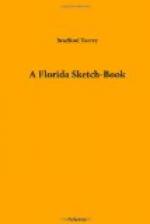One fine morning,—it was the 18th of February,—I had gone down the railroad a little farther than usual, attracted by the encouraging appearance of a swampy patch of rather large deciduous trees. Some of them, I remember, were red maples, already full of handsome, high-colored fruit. As I drew near, I heard indistinctly from among them what might have been the song of a black-throated green warbler, a bird that would have made a valued addition to my Florida list, especially at that early date.[1] No sooner was the song repeated, however, than I saw that I had been deceived; it was something I had never heard before. But it certainly had much of the black-throated green’s quality, and without question was the note of a warbler of some kind. What a shame if the bird should give me the slip! Meanwhile, it kept on singing at brief intervals, and was not so far away but that, with my glass, I should be well able to make it out, if only I could once get my eyes on it. That was the difficulty. Something stirred among the branches. Yes, a yellow-throated warbler (Dendroica dominica), a bird of which I had seen my first specimens, all of them silent, during the last eight days. Probably he was the singer. I hoped so, at any rate. That would be an ideal case of a beautiful bird with a song to match. I kept him under my glass, and presently the strain was repeated, but not by him. Then it ceased, and I was none the wiser. Perhaps I never should be. It was indeed a shame. Such a taking song; so simple, and yet so pretty, and so thoroughly distinctive. I wrote it down thus: tee-koi, tee-koo,—two couplets, the first syllable of each a little emphasized and dwelt upon, not drawled, and a little higher in pitch than its fellow. Perhaps it might be expressed thus:—




